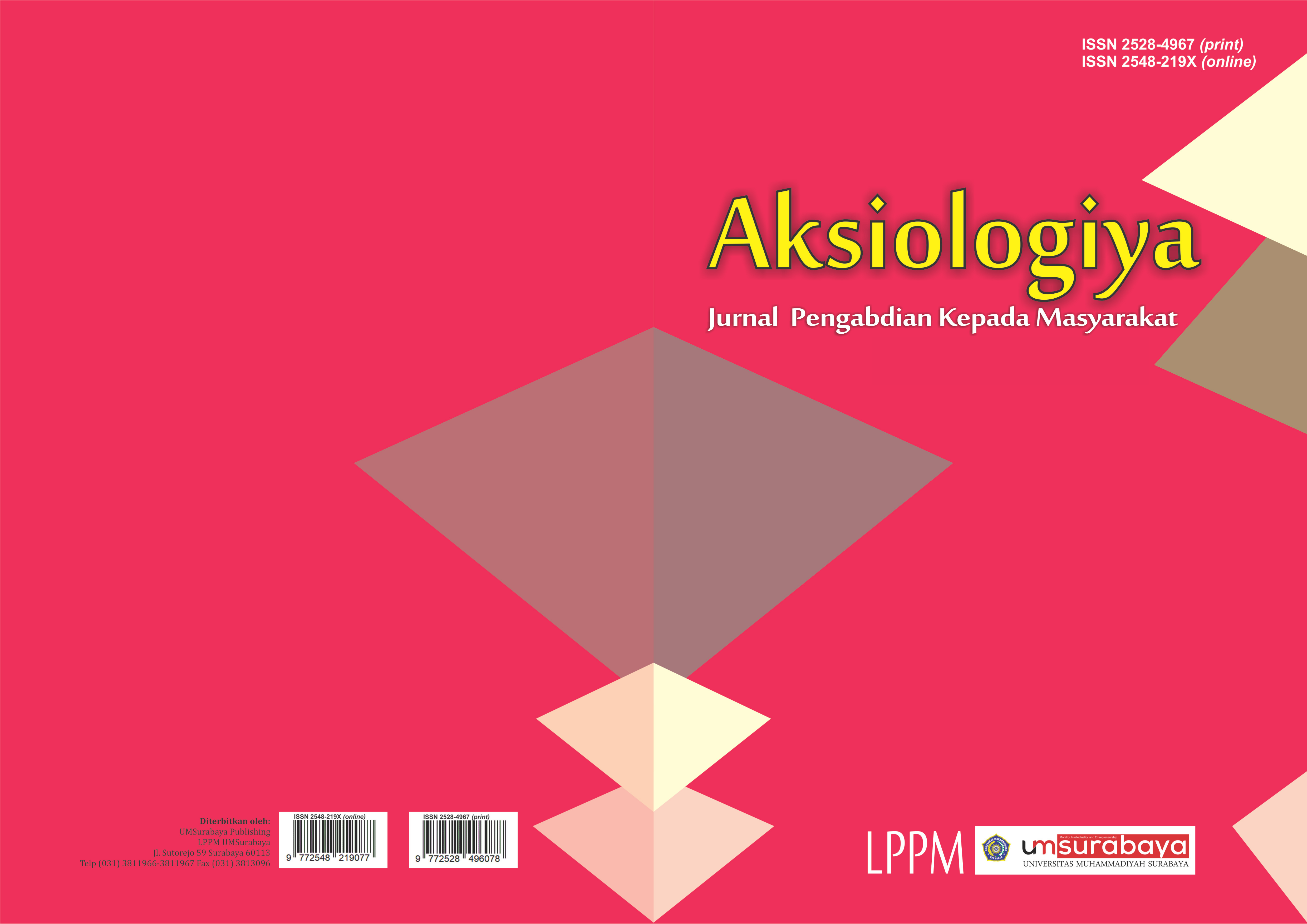Isi Artikel Utama
Abstrak
Abstrak
Life limiting illness (LLI) adalah penyakit yang tidak memiliki harapan untuk dapat disembuhkan, bahkan kematian akan menjadi konsekuensi langsung dari penyakit yang dideritanya. Pendekatan komprehensif yang dapat diberikan pada pasien dengan Life limiting illness (LLI), untuk meningkatkan kualitas pelayanan yaitu dengan menerapkan Patient Centered Care dalam pemberian Perawatan Palliative. Tujuan Pengabdian masyarakat untuk meningkatkan kemampuan petugas kesehatan di RS dalam memberikan pelayanan bagi pasien LLI mengunakan pendekatan Patient Centered Care dan Palliative care. Metode yang digunakan untuk meningkatkan kemampuan petugas adalah dengan menggunakan pelatihan dan role play mengenai peran masing-masing profesi dalam memberikan asuhan kepada pasien LLI. Kemampuan petugas terlihat pada Kepatuhan petugas dalam melakukan pelayanan pada pasien LLI, terlihat pada hasil Kepatuhan pengisian rekam medis secara terpadu oleh semua petugas kesehatan. Hasil dari pengabdian masyarakat dengan menggunakan metode pelatihan dan role play ini secara signifikan mempengaruhi peningkatan kekampuan petugas dalam mengasuh pasien LLI. Hasil yang paling terlihat adalah pengisian rekam medis secara terpadu yang diisi oleh petugas kesehatan.
Kata kunci: kepatuhan petugas; palliative care; patient centered care.
Â
The Implementation Patient Centered and Palliative Care In Life Limiting Illness Patients At PKU Gamping Yogyakarta Hospital
Â
Abstract
Life limiting illness (LLI) is a disease that has no hope of being cured, even death will be a direct consequence of the illness. A comprehensive approach that can be given to patients with Life Limiting illness (LLI), to improve the quality of service is to apply Patient Centered Care in the provision of Palliative Care. Community service aims to improve the ability of health workers in hospitals to provide services for LLI patients using the Patient Centered Care and Palliative care approaches. The method used to improve officers can use to training and role play regarding the role of each profession in providing care to LLI patients. The ability of officers is seen in the Compliance of officers in providing services to LLI patients, seen in the results of Compliance in filling medical records in an integrated manner by all health workers. The results of community service by using training methods and role play significantly influence the increase in the ability of officers to care for LLI patients. The most visible result is filling medical records in an integrated manner filled by health workers.
Keywords: compliance health service; palliative care; patient centered care.
Â
Kata Kunci
Rincian Artikel
Hak cipta artikel dimiliki oleh jurnal AKSIOLOGIYA
Ciptaan disebarluaskan di bawah Lisensi Creative Commons Atribusi-NonKomersial 4.0 Internasional.
Referensi
- Amelia, R., Lelo, A., Lindarto, D., & Mutiara, E. (n.d.). ANALYSIS OF FACTORS AFFECTING THE SELF-CARE BEHAVIORS OF DIABETES MELLITUS TYPE 2 PATIENTS IN BINJAI, NORTH SUMATERA-INDONESIA. 8.
- Arianti, A. (2017). IDENTIFIKASI GEJALA PADA PASIEN DENGAN LIFE LIMITING ILLNESS. Retrieved from http://repository.umy.ac.id/handle/123456789/13533
- Bergeson, S. C., & Dean, J. D. (2006). A Systems Approach to Patient-Centered Care. Jama, 296(23), 2848–2848. https://doi.org/10.1001/jama.296.23.2848
- Bezold, C. (2005). The future of patient-centered care: Scenarios, visions, and audacious goals. Journal of Alternative and Complementary Medicine (New York, N.Y.), 11 Suppl 1, S77-84. https://doi.org/10.1089/acm.2005.11.s-77
- Delaney, L. J. (2018). Patient-centered care as an approach to improving health care in Australia. Collegian, 25(1), 119–123. https://doi.org/10.1016/j.colegn.2017.02.005
- Epstein, R. M., & Street, R. L. (2011). The Values and Value of Patient-Centered Care. Annals of Family Medicine, 9(2), 100–103. https://doi.org/10.1370/afm.1239
- KemenKes, R. I. (2014). Profil Kesehatan RI 2013. Jakarta.
- KEMENKES RI. (2013). Riset Kesehatan Dasar (RISKESDAS) 2013. https://doi.org/10.1007/s13398-014-0173-7.2
- Lowe, P., & Mcbride-Henry, K. (2012). What factors impact upon the quality of life of elderly women with chronic illnesses: Three women’s perspectives. Contemporary Nurse, 41(1), 18–27. https://doi.org/10.5172/conu.2012.41.1.18
- Maulida, M. N., Oktadini, N. R., & Purnamasari, N. (n.d.). GAMBARAN PENGETAHUAN DAN SIKAP PERAWAT MENGENAI PERAWATAN PALIATIF. 5.
- Meterko, M., Wright, S., Lin, H., Lowy, E., & Cleary, P. D. (2010). Mortality among Patients with Acute Myocardial Infarction: The Influences of Patient-Centered Care and Evidence-Based Medicine. Health Services Research. https://doi.org/10.1111/j.1475-6773.2010.01138.x
- Sepúlveda, C., Marlin, A., Yoshida, T., & Ullrich, A. (2002). Palliative Care: The World Health Organization’s Global Perspective. Palliative Care, 24(2), 6.
- World Health Organization. (2016). World health statistics. 2016, 2016,. Retrieved from http://search.ebscohost.com/login.aspx?direct=true&scope=site&db=nlebk&db=nlabk&AN=1482449
Referensi
Amelia, R., Lelo, A., Lindarto, D., & Mutiara, E. (n.d.). ANALYSIS OF FACTORS AFFECTING THE SELF-CARE BEHAVIORS OF DIABETES MELLITUS TYPE 2 PATIENTS IN BINJAI, NORTH SUMATERA-INDONESIA. 8.
Arianti, A. (2017). IDENTIFIKASI GEJALA PADA PASIEN DENGAN LIFE LIMITING ILLNESS. Retrieved from http://repository.umy.ac.id/handle/123456789/13533
Bergeson, S. C., & Dean, J. D. (2006). A Systems Approach to Patient-Centered Care. Jama, 296(23), 2848–2848. https://doi.org/10.1001/jama.296.23.2848
Bezold, C. (2005). The future of patient-centered care: Scenarios, visions, and audacious goals. Journal of Alternative and Complementary Medicine (New York, N.Y.), 11 Suppl 1, S77-84. https://doi.org/10.1089/acm.2005.11.s-77
Delaney, L. J. (2018). Patient-centered care as an approach to improving health care in Australia. Collegian, 25(1), 119–123. https://doi.org/10.1016/j.colegn.2017.02.005
Epstein, R. M., & Street, R. L. (2011). The Values and Value of Patient-Centered Care. Annals of Family Medicine, 9(2), 100–103. https://doi.org/10.1370/afm.1239
KemenKes, R. I. (2014). Profil Kesehatan RI 2013. Jakarta.
KEMENKES RI. (2013). Riset Kesehatan Dasar (RISKESDAS) 2013. https://doi.org/10.1007/s13398-014-0173-7.2
Lowe, P., & Mcbride-Henry, K. (2012). What factors impact upon the quality of life of elderly women with chronic illnesses: Three women’s perspectives. Contemporary Nurse, 41(1), 18–27. https://doi.org/10.5172/conu.2012.41.1.18
Maulida, M. N., Oktadini, N. R., & Purnamasari, N. (n.d.). GAMBARAN PENGETAHUAN DAN SIKAP PERAWAT MENGENAI PERAWATAN PALIATIF. 5.
Meterko, M., Wright, S., Lin, H., Lowy, E., & Cleary, P. D. (2010). Mortality among Patients with Acute Myocardial Infarction: The Influences of Patient-Centered Care and Evidence-Based Medicine. Health Services Research. https://doi.org/10.1111/j.1475-6773.2010.01138.x
Sepúlveda, C., Marlin, A., Yoshida, T., & Ullrich, A. (2002). Palliative Care: The World Health Organization’s Global Perspective. Palliative Care, 24(2), 6.
World Health Organization. (2016). World health statistics. 2016, 2016,. Retrieved from http://search.ebscohost.com/login.aspx?direct=true&scope=site&db=nlebk&db=nlabk&AN=1482449


